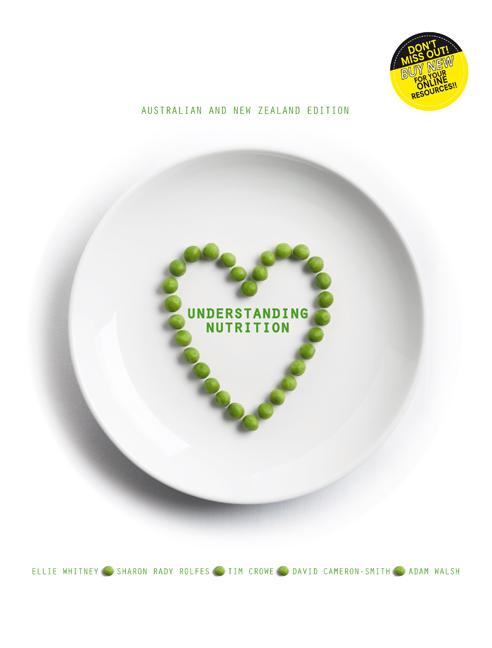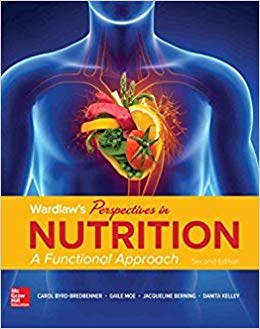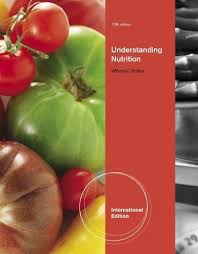Description
Understanding Nutrition Australian And New Zealand Edition 1st Edition By Eleanor Noss Whitney – Test Bank
1. An overview of nutrition
2. Planning a healthy diet
3. Digestion, absorption and transport
4. The carbohydrates: Sugar, starch and fibres
5. The lipids: Triglycerides, phospholipids, and sterols
6. Protein: Amino acids
7. Metabolism: Transformations and interactions
8. Energy balance and body composition
9. Weight management: Overweight and underweight
10. The water-soluble vitamins: B vitamins and vitamin C
11. The fat-soluble vitamins: A, D, E, and K
12. Water and the major minerals
13. The trace minerals
14. Fitness: Physical activity, nutrients, and body adaptations
15. Life cycle nutrition: Pregnancy and lactation
16. Life cycle nutrition: Infancy, childhood and adolescence
17. Life cycle nutrition: Adulthood and the later years
18. Diet and health
19. Consumer concerns about foods and water
Appendix A Cells, hormones, and nerves
Appendix B Basic chemistry concepts
Appendix C Biochemical structures and pathways
Appendix D Measures of protein quality
Appendix E Nutrition assessment
Appendix F Physical activity and energy requirements
Chapter 1 – An Overview of Nutrition
Multiple Choice
1. Features of a chronic disease include all of the following except
a. it develops slowly.
b. it lasts a long time.
c. it produces sharp pains.
d. it progresses gradually.
ANS: c
REF: 3
DIF: Knowledge Level
2. Characteristics of an acute disease include all of the following except
a. it develops quickly.
b. it progresses slowly.
c. it runs a short course.
d. it causes sharp symptoms.
ANS: b
REF: 3
DIF: Knowledge Level
3. What is the chief reason people choose the foods they eat?
a. Cost
b. Taste
c. Convenience
d. Nutritional value
ANS: b
REF: 3
DIF: Knowledge Level
4. All of the following are results of making poor food choices except
a. over the long term, they will reduce lifespan in some people.
b. they can promote heart disease and cancer over the long term.
c. over the long term, they will not affect lifespan in some people.
d. when made over just a single day, they exert great harm to your health.
ANS: d
REF: 3–5
DIF: Application Level
5. A child who developed a strong dislike of noodle soup after consuming some when she was sick with flu is an example of a food-related
a. habit.
b. social interaction.
c. emotional turmoil.
d. negative association.
ANS: d
REF: 4
DIF: Application Level
6. A parent who offers a child a favourite snack as a reward for good behaviour is displaying a food behaviour known as
a. social interaction.
b. reverse psychology.
c. positive association.
d. habitual reinforcement.
ANS: c
REF: 4
DIF: Application Level
7. A person who eats a bowl of cereal for breakfast every day would be displaying a food choice most likely based on
a. habit.
b. availability.
c. body image.
d. environmental concerns.
ANS: a
REF: 4
DIF: Application Level
8. Which of the following represents a food choice based on negative association?
a. A tourist from China who rejects a hamburger due to unfamiliarity
b. A child who spits out his mashed potatoes because they taste too salty
c. A teenager who grudgingly accepts an offer for an ice cream to avoid offending a close friend
d. An elderly gentleman who refuses a peanut butter sandwich because he deems it a child’s food
ANS: d
REF: 4
DIF: Application Level
9. The motive for a person who alters his diet due to religious convictions is most likely his
a. values.
b. body image.
c. ethnic heritage.
d. functional association.
ANS: a
REF: 4
DIF: Application Level
10. A person viewing an exciting sports match of her favourite team and eating because of nervousness would be displaying a food choice behaviour most likely based on
a. habit.
b. availability.
c. emotional comfort.
d. positive association.
ANS: c
REF: 4
DIF: Application Level
11. Terms that describe a food that provides health benefits beyond its nutrient contribution include all of the following except
a. neutraceutical.
b. designer food.
c. functional food.
d. phytonutritional food.
ANS: d
REF: 5
DIF: Knowledge Level
12. What is the term that defines foods that contain non-nutrient substances whose known action in the body is to promote wellbeing to a greater extent than that contributed by the food’s nutrients?
a. Fortified foods
b. Enriched foods
c. Functional foods
d. Health enhancing foods
ANS: c
REF: 5
DIF: Knowledge Level
13. Non-nutrient substances found in plant foods that show biological activity in the body are commonly known as
a. folionutrients.
b. inorganic fibers.
c. phytochemicals.
d. phyllochemicals.
ANS: c
REF: 5
DIF: Knowledge Level
14. The complete lining of a person’s digestive tract is renewed approximately every
a. 3–5 days.
b. 3 weeks.
c. 1–2 months.
d. 6–12 months.
ANS: a
REF: 6
DIF: Application Level
15. Approximately how much water (kg) would be found in a healthy, 70-kilogram person?
a. 12
b. 24
c. 30
d. 41
ANS: d
REF: 6
DIF: Application Level
16. By chemical analysis, what nutrient is present in the highest amounts in most foods?
a. Fats
b. Water
c. Proteins
d. Carbohydrates
ANS: b
REF: 6
DIF: Knowledge Level
17. Which of the following is not one of the six classes of nutrients?
a. Fiber
b. Protein
c. Minerals
d. Vitamins
ANS: a
REF: 7
DIF: Knowledge Level
18. A nutrient needed by the body and that must be supplied by foods is termed a(n)
a. neutraceutical.
b. metabolic unit.
c. organic nutrient.
d. essential nutrient.
ANS: d
REF: 7
DIF: Application Level
19. The energy in food is normally expressed in kilojoules per gram (kJ/gram) but in some countries (particularly the United States) it is expressed in
a. kilocalories.
b. kilograms.
c. kilometers.
d. kilonewtons.
ANS: a
REF: 8
DIF: Knowledge Level
20. All of the following are classified as macronutrients except
a. fat.
b. protein.
c. calcium.
d. carbohydrate.
ANS: c
REF: 7
DIF: Application Level
21. Which of the following is an example of a macronutrient?
a. Protein
b. Calcium
c. Vitamin C
d. Vitamin D
ANS: a
REF: 7
DIF: Application Level
22. Which of the following is classified as a micronutrient?
a. Iron
b. Protein
c. Alcohol
d. Carbohydrate
ANS: a
REF: 7
DIF: Application Level
23. Which of the following is an organic compound?
a. Salt
b. Water
c. Calcium
d. Vitamin C
ANS: d
REF: 7
DIF: Application Level
24. Which of the following is characteristic of an essential nutrient?
a. Cannot be found in food
b. Cannot be degraded by the body
c. Cannot be made in sufficient quantities by the body
d. Cannot be used to synthesise other compounds in the body
ANS: c
REF: 7
DIF: Application Level
25. Which of the following most accurately describes the term organic?
a. Products sold at health food shops
b. Products grown without use of pesticides
c. Foods having superior nutrient qualities
d. Substances with carbon-carbon or carbon-hydrogen bonds
ANS: d
REF: 7
DIF: Application Level
26. Which of the following is an organic nutrient?
a. Fat
b. Water
c. Oxygen
d. Calcium
ANS: a
REF: 7
DIF: Application Level
27. Approximately how many nutrients are considered indispensable in the diet?
a. 15
b. 25
c. 40
d. 55
ANS: c
REF: 7
DIF: Knowledge Level
28. Which of the following cannot add fat to the body?
a. Alcohol
b. Proteins
c. Carbohydrates
d. Inorganic nutrients
ANS: d
REF: 7
DIF: Application Level
29. Which of the following is an example of a micronutrient?
a. Fat
b. Protein
c. Vitamin C
d. Carbohydrate
ANS: c
REF: 7
DIF: Application Level
30. Which of the following nutrients does not yield energy during its metabolism?
a. Fat
b. Proteins
c. Vitamins
d. Carbohydrates
ANS: c
REF: 7
DIF: Knowledge Level





Be the first to review “Understanding Nutrition Australian And New Zealand Edition 1st Edition By Eleanor Noss Whitney – Test Bank”